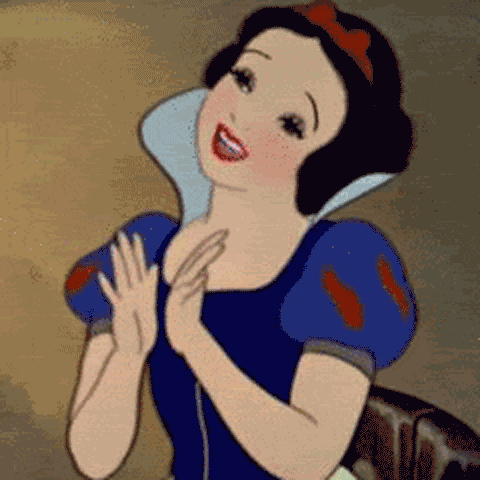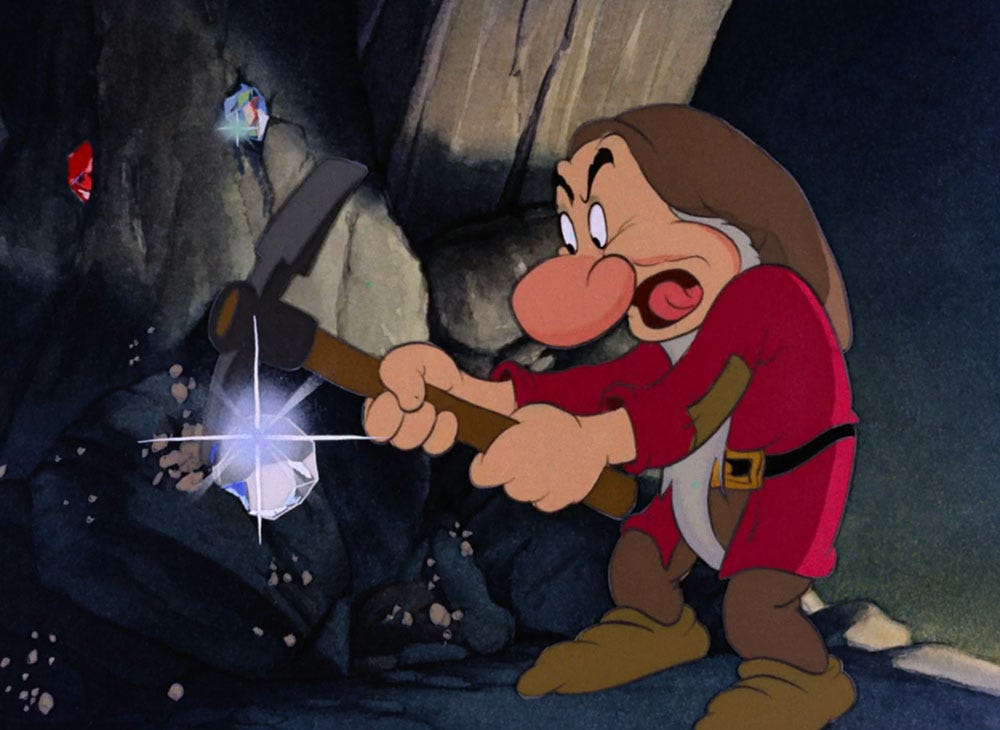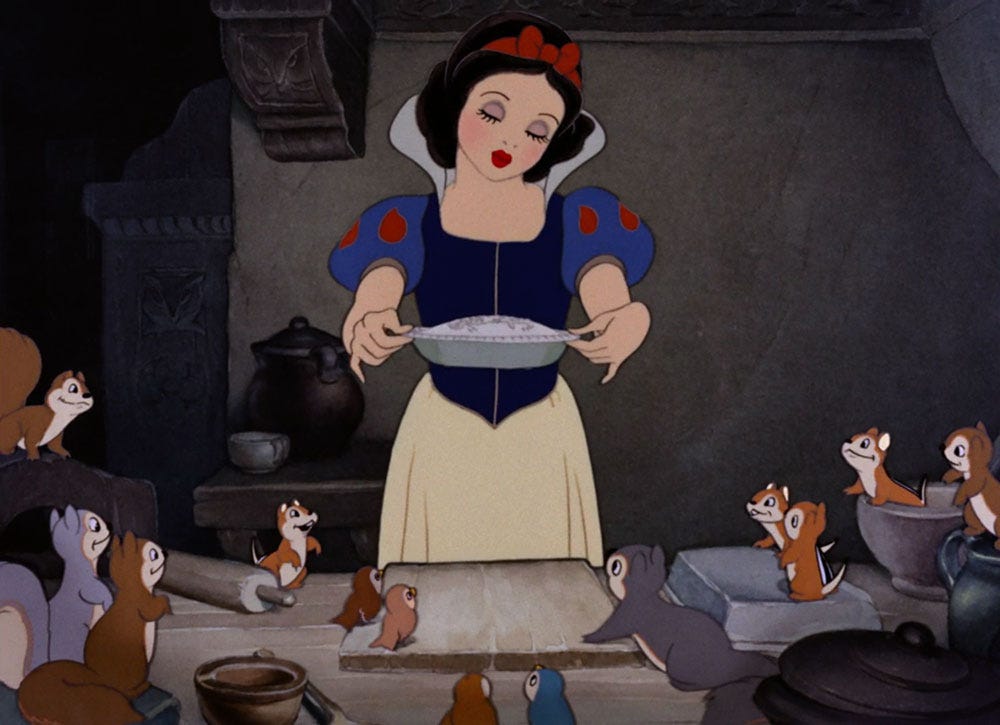GROSS/27 1937 - delirium in the forest
Snow White and the Seven Dwarfs is not normal. Not normal at all.
Gross is every year’s top-grossing movie, since 1913, reviewed.
SNOW WHITE AND THE SEVEN DWARFS, DAVID HAND, WALT DISNEY PRODUCTIONS, 1937, 83 MINUTES.
My problem, as ever with this process, is that when I cue up a movie on the mighty Samsung and mentally prepare to enter its sphere - its invented world - I have my big sceptic’s hat on. And my big sceptic’s boots and my thick sceptic’s glasses. I pour myself a big mug of sceptic’s coffee (black), press ‘play’ and wait to be unimpressed or bored or maybe even repelled.
And it never bloody happens. There’s always something. Always some charm or eccentricity or - more often, really - some beauty or novelty or even magnificence, that trips me up and leaves me gushing. And I’m back in la-la-land.
Listen, before you say anything, this review’s too long. Here’s the TL;DR:
Snow White marks the end of the chaotic, spiky, liberatory early period and the arrival of the rational, predictable spaces of modern animation. It’s the first blockbuster movie of the vast, global animated-storytelling economy. In the story, the mode of production is approximately feudal and the gender politics primitive. And to cap it all, the aesthetic is a kind of Victorian animist storybook-acid-trip hybrid. Walt Disney, we salute you.
And another thing: what I ought to have done here is another double-bill, like I did for 1918, because La Grande Illusion also came out in 1937 and that is a beautiful, complicated work of art and would have provided a kind of ethical mirror to hold up to this (equally complicated) invention. And it was nominated for an Oscar so that would have been my justification for including it. I might stick it in anyway, before I get to 1938.
Welcome, Your Royal Highness
Princess Snow White is here. She’s floated into the timeline from a faraway place. Snow White and the Seven Dwarfs is a delirious work of art, a strange - sometimes quite trippy - excursion to a place from folklore, from the pre-modern, from deep in the forest of your psyche (not my psyche, definitely your psyche).
It’s a famous movie, of course - the first feature-length animation, the first in a long series of the most loved films ever - and, by a mile, the top-grossing movie of 1937. It’s also, evidently, a work of art so precious that its owners have been prepared to spend hundreds of millions of dollars to change the law all around the developed world to protect it from use by others.
There’s a lot going on. To begin with, there’s the technical achievement - not just the awe-inspiring creative challenge of transforming hand-drawn art into a smooth and coherent motion-picture story but also the organisational breakthroughs that were necessary to build a machine that could create these things. Proper Henry Ford-level innovation. A whole industrial culture that’s been adopted and adapted by every movie economy and animation studio since.
I first watched this film a long time ago, of course (visualise small me in a small-town flea-pit in the middle of Ireland, please), I’ve obviously been conscious of its presence in the culture ever since (but I suspect I’ve never watched it all the way through since then). It’s a touchstone for Hollywood, for cinema in general, for animated storytelling. Also for showbusiness economics, intellectual property and ugly corporate overreach, of course. But what else is there?
Animation’s end
In Snow White we’re obviously at the beginning of something important - of global animation culture, of an art-form that went on to consume a large fraction of the cinema economy. But we’re also at the end of something - at the end of the first sketchy and experimental era of movie animation, during which stories and settings were always incomplete and fantasmagoric, often disorienting or unhinged. In these early animated films - from close to the beginning of cinema to the mid-thirties - constant action and kinetic physical extremes are commonplace and the laws of physics only periodically apply. Hungry Felix enters the house via the crack under the front door, later he’s thrown from a plane high in the sky and runs across the air to catch up. Consistency and continuity can be suspended arbitrarily. Nothing is fixed.
Snow White is the end of all that. Walt Disney definitively draws a line under the wild and peremptory and often violent era of early Ignatz Mouse and Krazy Kat, Felix and Betty Boop and all the other weirdos. The flat, spiky, sliding and rotating otherworld of early animation is gone. The arrival of Newtonian physics and rational Minkowski spacetime in animated films has essentially killed the undisciplined, edenic world of early animation stone-dead and over night, much in the way that sound killed the silents within months.
Normality re-asserts itself
In this feature Disney and his director David Hand consciously match the logic of their craft - this wild, new form at one remove from the real - to that of live-action filmmaking. Animators on Snow White had to ground themselves, to respect the physics of the real world. The vertiginous, playful disrespect for gravity and perspective and consistent dimension of the early period is gone, replaced by shots and camera movements - zooms, pans, crane-shots and tracking shots recognisable from live action. Spaces obey the conventions of axes and directions and volumes. It’s an unreal, fully-invented world but it conforms to the rules and conventions of the ordinary one - the one we all inhabit.
None of this seems very remarkable today but the animated world we’ve been allowed access to since 1937 is essentially unchanged. This is Walt Disney’s world - familiar, comprehensible, quite often prosaic. Streets and towns and landscapes all have the scale of real streets and towns and landscapes - usually American streets and towns and landscapes, of course. Remarkable things may happen - and they do - but they’ll happen in places and at scales we recognise.
At the Disney studio men and women at drawing tables, artists in the tradition of Dürer and Raphael and a million commercial and comicbook artists since, create in Snow White sequences of images that, together, reproduce not the flight of an imagination but the movement of a camera across a studio floor. It’s a remarkable shift, something we take for granted now but one that’s material to the whole history of the form.
It’s as if Disney deliberately set aside all the crazy creative opportunities available to the early creators in animation - all the woozy distortions and chaotic revisions to solid reality - all essentially foregone and, to this day, even the most innovative and challenging contemporary animation takes place in the same, stable, x-y-z space. And this, of course, almost certainly explains the huge success of the form. Could the universal parallel world of animated film that we all now regularly visit have been built in the jagged, non-compliant habitat of Felix the cat and Oswald the lucky rabbit? Disney’s insight was that it could not, that animated space would have to correspond broadly with the space of the swashbuckler and the film noir and the Western otherwise it would be alienating and never become a truly popular form.
It’s against this new naturalist backdrop that Snow White escapes the ghastly space of the castle where she is not free and, going deep into the forest, enters the happier space of the dwarfs’ cottage, where, she promises them, she’ll wash and cook and clean and where she is, let’s face it, not free.
It’s hard not to read all this as a kind of capitalist realism. Disney and the studios who came in behind him - into the economy of pretend reality - were - consciously or otherwise - collapsing the unlimited spaces and illimitable, joyful motion of the animated universe into the diminished dimensions of the mid-20th Century real. Animation before Snow White was about escape into the upper dimensions - silly, revolutionary, wildly free. After Snow White it was grimly collapsed, closed-off.
In the present day, in the hyper-refined animations of Pixar and Dreamworks that inherit the Disney worldview, scenes and worlds are modelled in advance - given a precise, consistent, invariant form against which every scene can be set (or generated by an AI). Animators don’t even have to think about the shape of the world in which they work. It’s a given. Like capitalism.
Back to the forest
There’s a fairytale here - an old folk story filtered through the Grimms and then through a century or more of pop culture and a hit Broadway play and this final 20th-Century revision by Walt Disney in his brand new Californian story factory. But what, in retelling the story, does Disney give us? Who is this young woman? These small workers? These apparently sentient animals? This ghastly, exploitive Queen?
In Chaplin’s Modern Times it was possible to find workers and bosses, a whole constellation of innocents and villains - and the clown himself, of course. A comprehensible narrative of capital vs individual and of love vs indifference and cruelty. In King Kong we’re given a pretty direct statement about the triumph of money over nature. In The Covered Wagon it’s the dark logic of settler economics, love at the edge of the republic. But what’s the deal here in the forest?
Well, there’s at least one working diamond mine - and on the evidence it’s highly productive - and there’s one vast castle occupied by the area’s feudal ruler (who seems to be an actual Queen, not just a baroness or a big landowner). She’s a generic, fairytale Queen, though, so she has no court, no apparent government - only terrified flunkies (and that mirror). No army either, as far as I can tell. What does she rule over - presumably not just this patch of forest and its handful of variagated inhabitants? Where does the Prince, of whom Snow White dreams and who shows up periodically to woo her, go during his long absences? Is he away at the crusades? Fighting the Imperial Catholic League at Leipzig? Bothering another Princess in a neighbouring Kingdom?
Are there other settlements? Some unforested land that’s farmed somewhere? Or a market town? A church? And a yeoman class. I mean the dwarfs aren’t yeomen are they? Since they seem to work like navvies and have a subsistence life in the cottage. Is it safe to assume they’re tenants? Do they pay a tithe - in huge, glinting diamonds - to the Queen?
We don’t know. Production relations here in the forest are occluded. This is Disney’s manner. He was never publicly political but his whole life-work is essentially a conservative project. The ideological package of family, work, respect for authority and individual courage is always present. Disney became - and remains - a powerful engine for cultural and economic conformity. In the present day the orthodoxy the studio reproduces is different - it’s intersectional, impeccably diverse and inclusive, but orthodox nonetheless. It’s the orthodoxy of the 21st Century Western corporation (and it makes some people furious).
Social and economic structures in the forest are uncertain, time is plastic. So is space. Our location is vague and never actually fixed. We’re just deep in the forest - and this forest is a slightly out-of-focus backdrop to an approximately mediaeval story. There were once forests like this all over Europe, even in Britain - enormous, sparsely-occupied but they weren’t at all disordered, they were always managed and cropped and policed. I like to think that alongside the Queen in this story there’s a very well-run forest bureaucracy, with provision for safety inspections of diamond mines and animal welfare and a nicely-run health service that will look after comatose princesses.
But weirdness persists
Let’s back up and consider the shape of this thing a bit. This 83-minute adventure is in some ways a very conventional creation. The classic three acts are present but the sequence is oddly compressed. This is a confident first feature but much about the structure is tentative, even clumsy. We’re rushed through on a collapsing timeline that accelerates exhaustingly. The first act, during which Snow White leaves the castle and winds up mopping and dusting in the dwarfs’ cottage takes up more than half the movie and she doesn’t even meet the dwarfs until 35 minutes in.
The second act - the crisis, during which it’s all fun and games up until the moment everything goes wrong and the Princess winds up insensible on the cottage floor, poisoned by the wicked Queen - lasts another twenty minutes. The climactic final act, though, is barely ten minutes and packs in a frenetic, mountainside action sequence (with a surprisingly, I don’t know, North by Northwest feel?) and the Princess’s terribly sad interment under glass and the silly, light-operatic happy ending we were all expecting (oh, unnamed Prince, now you show up?). It feels awkwardly abbreviated, honestly as if the budget ran out or a release deadline cut everything short.
And then - I honestly can’t skip this bit - there’s the wildly odd aesthetic universe of Snow White. We’re a long way from the psychedelic phase of Disney’s existence but it’s unarguable that this movie has a heightened aesthetic, a kind of late-Victorian opium-den vibe. We’ve all so thoroughly absorbed the look of these early Disney features that we barely notice it but Snow White’s whole look is unarguably disconcerting - wide-eyed, pre-Raphaelite-gothic-junkie. Snow White’s flat-white complexion and her hyperreal highlights - crimson lips, rosy cheeks, hair ribbon and so on - set against the dwarfs’ robust mini-miners’ physiques and builder’s tans (and the profoundly bad trip of all those sodding animals) create a kind of delirious tableau of human and humanish and definitely not human. It’s enough to send a person running from the forest.
Marxists have always been obsessed by Disney and by animated film. Something about violence, fictional labour and the modern subject. Walter Benjamin included Mickey Mouse in the first two versions of his famous ‘The Work of Art in the Age of Mechanical Reproduction’ but took him out of the final version because Adorno shamed him. In another essay Benjamin considers Mickey alongside Chaplin and Eisenstein. He and the rest of the Frankfurt School had a kind of apocalyptic-ecstatic reading of these movies: "In these films, mankind makes preparations to survive civilization" wrote Benjamin. For Adorno “Donald Duck in the cartoons and the unfortunate victim in real life receive their beatings so that the spectators can accustom themselves to theirs.” The toons are softening us up for exploitation and extermination.
I’m an idiot so it completely passed me by that the studio is planning a live action remake of Snow White for a 2025 release. It has, you won’t be surprised to know, triggered a full culture wars freak-out. The main issues are that a) the new Snow White is not sufficiently snow white - she has mixed Colombian-Polish ancestry (thinking about it, this central-European fairytale is probably set somewhere in the forests of the old Polish–Lithuanian Commonwealth so that seems appropriate), b) Snow White’s puzzling devotion to the nameless Prince has been revised - she now aspires not to ‘live happily ever after’ but to ‘leadership’ and c) the dwarfs have been updated - they’re now CGI fantasy creatures in a variety of sizes. I give you The Guardian and Spiked! You know, for balance.
Lots of good stuff in J. Hoberman’s review of Hollywood Flatlands: Animation, Critical Theory and the Avant-Garde in the LRB.
Donald Crafton’s Before Mickey – The Animated Film 1898–1928 is superb on the chaotic period.
Here's a list of all the top-grossing films since 1913 and here's my Letterboxd list and another top-grossing list.








Steve- I really enjoyed this one. Especially when you said: "Social and economic structures in the forest are uncertain, time is plastic. So is space. Our location is vague and never actually fixed. We’re just deep in the forest - and this forest is a slightly out-of-focus backdrop to an approximately mediaeval story." There's definitely something about Snow White that struck a strange chord in the time-space continuum. The glass box, the poisonous apple, the woodland creatures, not to mention the sleep-to-kiss arc ... It really made me wonder what exactly about this tale that made the story so popular at the time of its inception. Escapism, maybe. But perhaps the better explanation is, to your point: is that it is not normal at all. And maybe that's the draw. I appreciate this. Hope you're well this week? Cheers, -Thalia